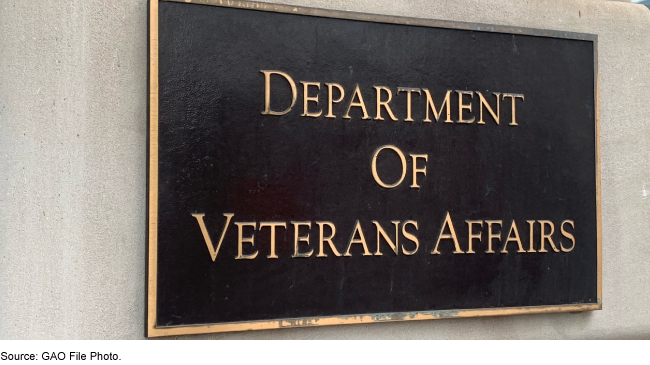VA Health Care: Organization of the Office of Mental Health and Suicide Prevention
Fast Facts
In this Q&A report, we review how the Department of Veterans Affairs has organized its suicide prevention program.
In 2017, VA combined its suicide prevention and mental health programs into one office. Officials said that this facilitated internal coordination, but that suicide prevention staff had less autonomy to make decisions.
VA decided to move the suicide prevention program back into a separate office in 2023—in part to convey the high priority of the department's suicide prevention efforts. We've outlined criteria for evaluating organizational placements in our prior work, which could help VA as it proceeds with this latest change.

Highlights
What GAO Found
The Department of Veterans Affairs (VA) bases its approach for suicide prevention on its 2018 National Strategy for Preventing Veteran Suicide. This strategy outlines a comprehensive public health approach to suicide prevention that includes a combination of (1) clinically-based interventions, such as suicide risk screening for individual patients, and (2) community-based programs and services, such as programs to promote firearm safety to the public to reduce the risk of suicide by firearms.
In 2017, the Veterans Health Administration (VHA) organizationally combined the Office of Suicide Prevention and the Veterans Crisis Line——which GAO refers to collectively as suicide prevention programs—with mental health policy and operations in its newly created Office of Mental Health and Suicide Prevention (OMHSP). VHA stated that it created OMHSP to ensure oversight and management of evidence-based strategies within VHA and the community related to identifying veterans with mental health care needs, identifying veterans in crisis, and decreasing the rate of veteran suicide.
OMHSP leadership officials identified benefits and challenges related to the placement of suicide prevention programs within OMHSP. For example, OMHSP's leadership officials reported that including suicide prevention and mental health within the same office facilitated internal coordination, which was beneficial when implementing new legislation that targeted suicide prevention and mental health issues. However, Suicide Prevention Branch officials reported challenges related to the office's public health suicide prevention efforts. For example, officials said their placement within OMHSP has given them less autonomy with decision-making, such as decisions about suicide prevention initiatives, which require multiple levels of approval.
In July 2023, VHA approved a number of changes to its organizational structure that include moving both the Suicide Prevention Program and Veterans Crisis Line out of OMHSP into a separate program office within VHA's Office for Clinical Services. VHA conducted an assessment to determine the best placement for these programs. VHA's assessment and officials GAO spoke with identified several benefits and challenges related to this organizational change. The benefits included the importance of having the Suicide Prevention Office in a more elevated position within Clinical Services given its priority within the department and its need to coordinate across multiple VHA offices. The challenges included that keeping suicide prevention within the Office for Clinical Services could give the impression that suicide prevention is solely a clinical issue. VHA documents indicate that it plans to implement this change in 2024. As VHA implements these organizational changes, it will be important for it to determine whether this structure achieves the benefits it has anticipated and addresses anticipated, as well as any unanticipated, challenges or risks.
Why GAO Did This Study
Suicide is a persistent public health problem facing all populations, but particularly veterans. Veterans suffer a disproportionately higher rate of suicide compared to non-veterans. An average of almost 18 veterans died by suicide each day in 2021—a rate about 72 percent higher than the general adult population. VA reported that about 62 percent of the veterans who died by suicide in 2021 had not obtained recent health care through VHA. VHA works to build networks of support, communication, and health care across communities in which veterans live and work to help prevent deaths by suicide of veterans who do not obtain care through VA' health system.
Suicide prevention is VA's stated top clinical priority. VHA's suicide prevention programs have the lead responsibility for overseeing and implementing the department's suicide prevention initiatives. Among its responsibilities, the Suicide Prevention Program helps implement VA's National Strategy. VHA's Crisis Hotline is a national toll-free number that supports veterans in emotional crisis. Since establishing these programs in 2007, VHA has moved their organizational placement within various program offices at its national headquarters, also referred to as the central office, multiple times.
In May 2017, both suicide prevention programs were placed alongside VHA's mental health programs within the newly established OMHSP. However, in July 2023, VHA approved a number of changes to its organizational structure, including changes to the placement of these suicide prevention programs.
GAO conducted its review of VA's management of its mental health and suicide prevention services, including OMHSP's organizational structure, pursuant to law. This report answers key questions related to the organization of OMHSP and its suicide prevention programs.
For more information, contact Alyssa M. Hundrup at (202) 512-7114 or hundrupa@gao.gov.
